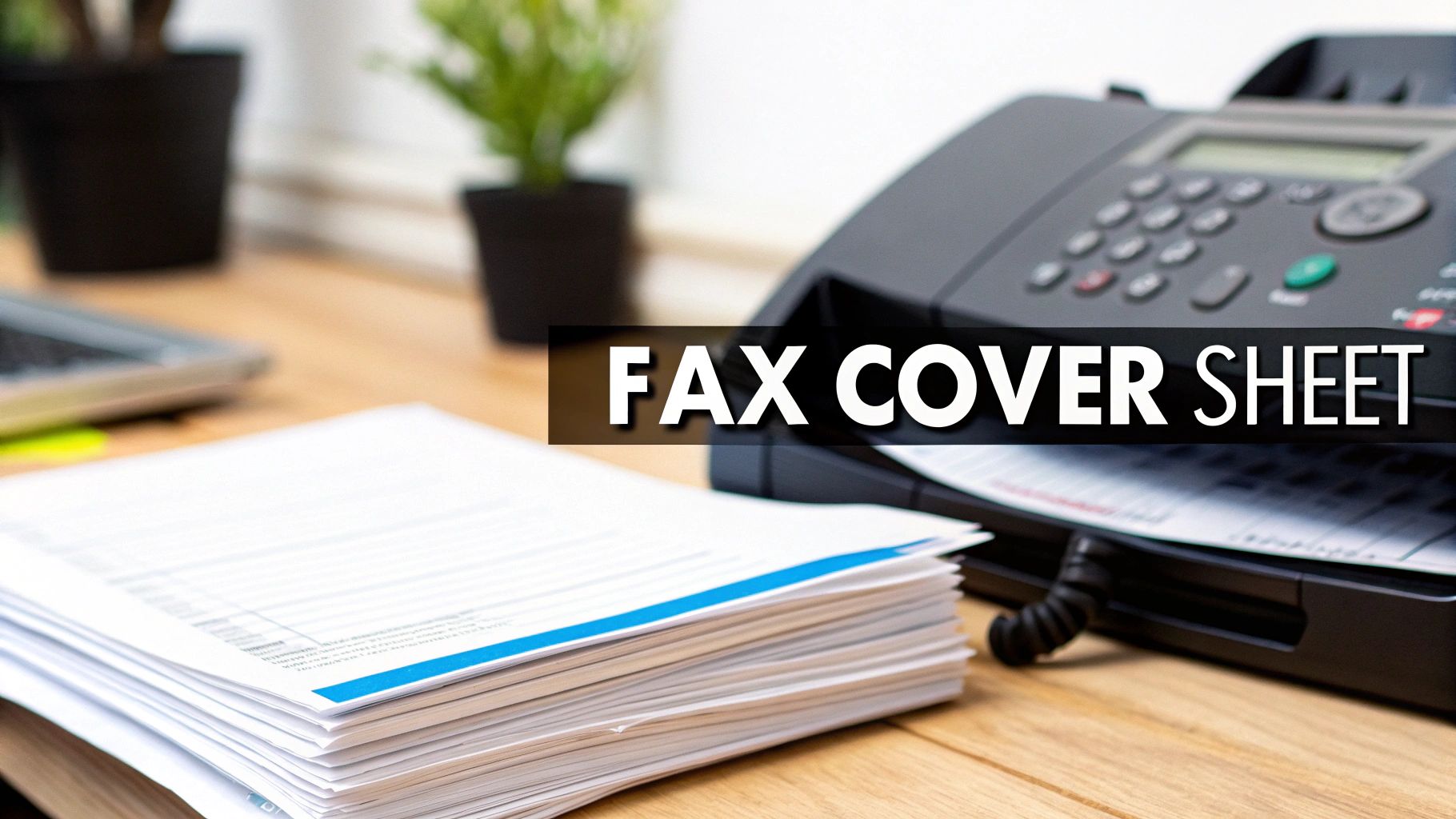A fax cover sheet template is far more than a simple formality. It’s a crucial piece of the puzzle that ensures your documents land securely, professionally, and in the right hands. Think of it as the firm, professional handshake before you get down to business, giving the recipient all the context they need in a single glance.
Why a Fax Cover Sheet Still Matters
In a world buzzing with instant messages and emails, you might think faxing is a relic from a bygone era. That's a common misconception, but it overlooks a key reality in modern business, legal, and healthcare communications. Faxing holds its ground as a trusted method for sending sensitive documents precisely because of its security and reliability—and the fax cover sheet is the cornerstone of that entire process.
Imagine sending a valuable, time-sensitive package with no shipping label. Where would it go? Who would know what’s inside or who sent it? A fax zipping through the lines without a cover sheet faces the same chaotic fate. It can easily get lost in a busy office, be picked up by unauthorized eyes, or be completely misinterpreted without that critical context.
The Professional First Impression
A well-designed fax cover sheet template is the face of your communication. It immediately signals that you're credible and that the contents are important.
- Clarity and Direction: It clearly points to the intended recipient, preventing your document from languishing on a shared printer tray.
- Essential Context: It lays out the sender's details, the date, and a subject line, giving the recipient everything they need to understand and act on the fax right away.
- Brand Consistency: For businesses, adding a logo and company info reinforces your brand identity and professionalism with every single fax you send.
A fax cover sheet isn't just a piece of paper; it's a vital instrument for security, compliance, and professionalism. It ensures your message is not only received but also respected and handled correctly from the moment it arrives.
A Surprising Global Presence
The stubborn relevance of faxing isn't just a hunch. Despite the rise of countless digital alternatives, fax technology maintains a surprisingly strong foothold across the globe. Recent data shows there are still over 43 million active fax machines worldwide, transmitting a staggering 17 billion documents each year.
Key economies like the USA, Japan, and Germany remain significant users. In fact, some industries in Japan still rely on fax for over 50% of their document transmissions. This persistence proves that knowing your way around a fax cover sheet template is still a valuable skill for secure business, both at home and abroad. You can find out more about how faxing is still used in business today.
Using a standardized template is a simple step that pays off big, significantly reducing the risk of miscommunication while boosting the security of your documents. This is especially true in tightly regulated sectors like healthcare and law, where one misdirected document can spiral into serious compliance headaches. A template creates a repeatable, protective system for your information and your organization.
Let's break down the core advantages of using a template for every fax you send.
Core Benefits of Using a Fax Cover Sheet Template
A solid template does more than just look good; it brings tangible benefits to your workflow and protects your communications. Here’s a quick look at why it’s a non-negotiable for serious faxing.
| Benefit | Why It Matters for Your Business |
|---|---|
| Professionalism | A clean, branded cover sheet establishes instant credibility and shows you take your communications seriously. |
| Clear Routing | It acts like a digital GPS, ensuring the document gets to the right person or department without getting lost. |
| Enhanced Security | By including confidentiality notices, it helps meet compliance standards (like HIPAA) and protects sensitive info. |
| At-a-Glance Context | The recipient immediately knows who it's from, what it's about, and how many pages to expect. |
| Efficiency | A ready-to-go template saves time and eliminates the need to create a cover sheet from scratch for every fax. |
| Error Reduction | Standardized fields ensure no critical information is accidentally left out, preventing follow-up calls and delays. |
In short, a template isn't just about saving a few minutes. It's about building a reliable, professional, and secure communication process from the ground up.
The Anatomy of a Professional Fax Cover Sheet
Think of an effective fax cover sheet as the dashboard of a car. Every gauge and light gives you critical, at-a-glance information, ensuring your document's "journey" is smooth, direct, and lands exactly where it needs to. It’s more than a simple checklist; understanding the purpose behind each part turns a basic page into a powerful communication tool.
Let's break down the core components that make up a truly professional fax cover sheet. Once you get the "why" behind each field, you can create or choose a template that’s not just functional, but also boosts your credibility and keeps your documents secure.
Essential Sender and Recipient Details
First and foremost, the cover sheet’s job is to get the fax into the right hands. It’s the address on an envelope. Without it, your important papers could get lost in a generic office inbox, never to be seen again.
- To (Recipient): Always use the person's full name and, if you know it, their department. This is absolutely crucial in large organizations.
- From (Sender): Your full name and company are non-negotiable. This tells the recipient who sent the fax and gives them a clear point of contact.
- Fax Numbers: This is where most errors happen. Double-check both your fax number and the recipient's. One wrong digit is the number one reason for a failed transmission.
- Contact Information: Always add your phone number and email address. This gives the recipient an easy way to reach you if there are transmission problems or they have questions.
This handy infographic shows just how much a well-structured template can do for you.
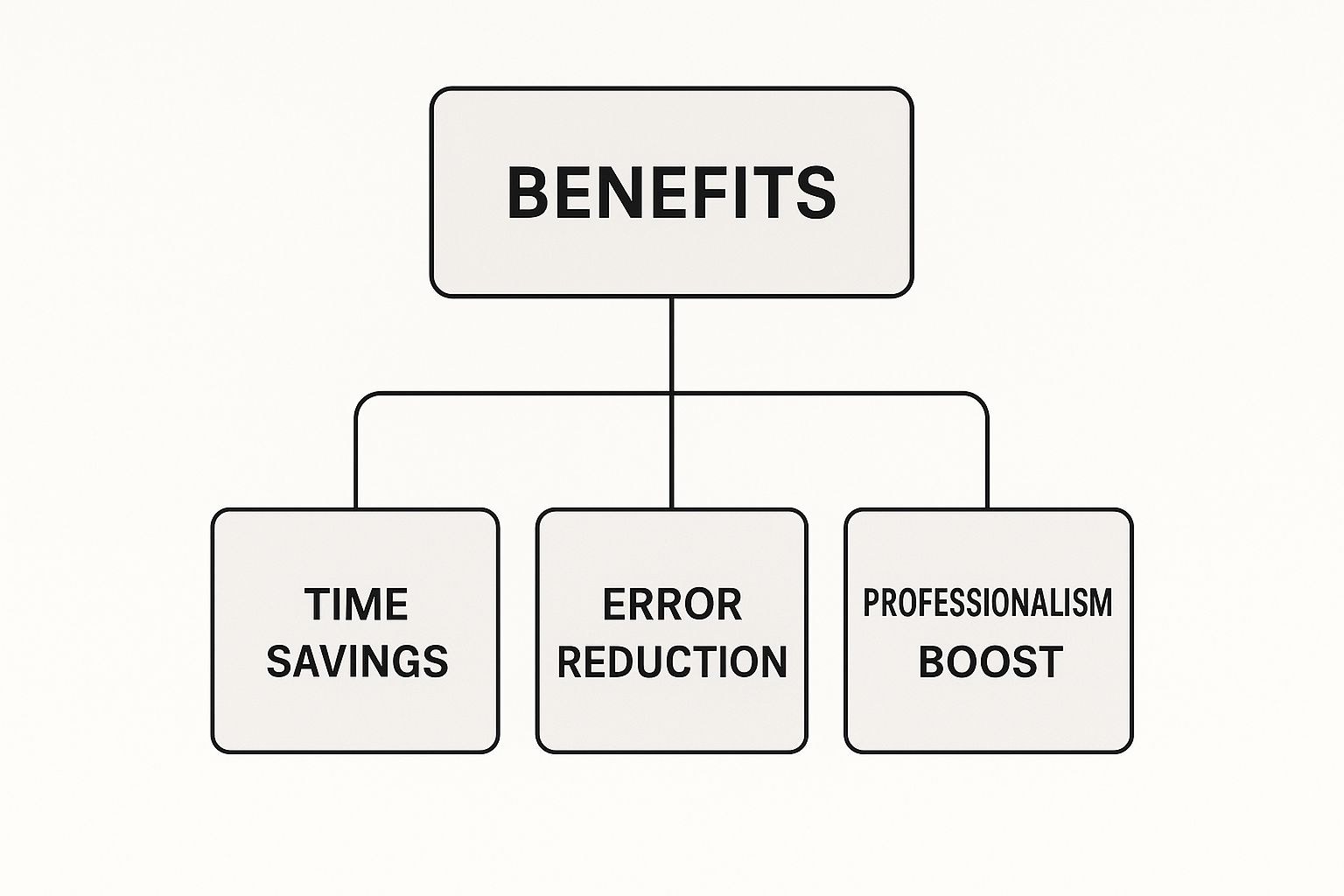
As you can see, a good template streamlines your workflow, cuts down on costly mistakes, and gives your communications an instant professional edge.
Key Information for Context and Security
Beyond just names and numbers, a cover sheet provides vital context and a few safeguards against common issues. These elements answer the immediate questions your recipient will have.
The Date field is simple but powerful, creating a clear timestamp that can be essential for business and legal records. Right after that comes the Subject Line. This is your chance to summarize the fax’s purpose in a few words—think "Invoice #5829" or "Signed Contract for Project Alpha." A clear subject helps the recipient prioritize it correctly.
The single most important safeguard on a fax cover sheet is the Page Count. This field (e.g., "Pages: 1 of 5") tells the recipient exactly how many pages to expect, including the cover sheet. If they only receive four pages, they know right away the transmission failed and can ask you to resend it.
If you're interested in building your own documents, we've got you covered. Our guide on creating a printable fax cover sheet walks you through all the necessary steps and details.
Important Optional Elements
While the fields we’ve covered are must-haves, a few optional elements can take your cover sheet from good to great, adding professionalism and a layer of legal protection.
- Company Logo: This is a simple one. Adding your company logo reinforces your brand and creates a consistent, polished look for all your business communications.
- Comments or Message: This section gives you space for a brief, personal note. You could use it to add specific instructions, a friendly greeting, or highlight an urgent action item.
- Confidentiality Notice: If your fax contains any sensitive information, this is essential. It's a legal disclaimer stating the fax is only for the intended recipient and warns against unauthorized sharing, giving you a bit of legal cover.
Just as a fax cover sheet's anatomy ensures clarity, the structure of other professional documents matters, too. For more on this, you can learn about understanding professional document formats, like those used for international résumés, to sharpen all your communications.
How Modern Faxing Drives the Need for Templates
When you hear the word "fax," you probably picture a clunky machine humming away in a dusty office corner. But that image is seriously outdated. Faxing hasn't just survived; it's evolved. Today, faxing is mostly a digital, cloud-based process that gives you the iron-clad security of old-school faxing with the simplicity of sending an email. And this modern shift is exactly why a professional fax cover sheet template is more important than ever.
Think of it this way: when you send a document through an online fax service, it still has to get to its destination, which often means landing on a physical printer in a busy office. Without a cover sheet, your sensitive info is left exposed and directionless the second it prints out. The template is its bodyguard, making sure it arrives safely and gets into the right hands.
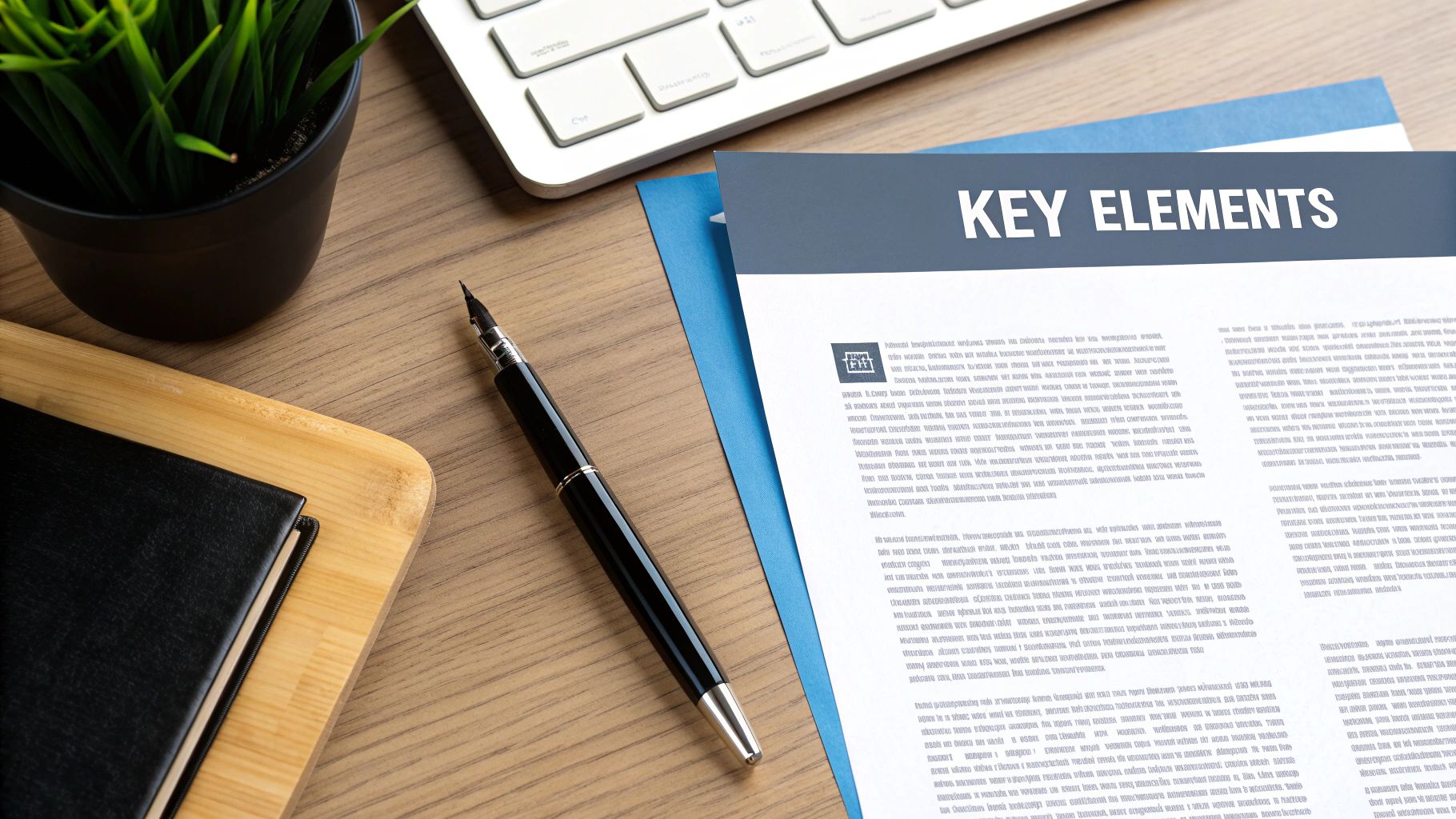
The Surprising Growth of Digital Faxing
Far from fading into obscurity, the fax market is actually making a comeback, all thanks to its digital makeover. Projections show a strong 11.05% compound annual growth rate between 2023 and 2028. The market is expected to climb from $3.18 billion to nearly $6 billion. This growth is being driven by the very industries that need the highest levels of security and documentation. You can dive deeper into these trends by exploring the full report on its continued use.
This modern faxing world thrives where legal and regulatory rules are non-negotiable. It’s still the preferred way to send official documents in many parts of the world. For example, a 2023 survey in Germany found that a staggering 82% of companies still use fax for official communications.
Why Security and Compliance Demand a Template
The biggest reasons for this continued reliance? Security and compliance. Industries like healthcare, finance, and government simply can't take the risks that come with less secure digital methods.
-
HIPAA Compliance in Healthcare: The Health Insurance Portability and Accountability Act (HIPAA) has incredibly strict rules for protecting patient health information (PHI). A HIPAA-compliant fax cover sheet is a critical safeguard. It must include a confidentiality disclaimer that legally warns anyone who sees it that the contents are private and protected.
-
Legal and Financial Documentation: In the legal and financial worlds, faxes provide a verifiable record that a document was sent and received. A cover sheet adds another layer of formality and traceability, clearly marking documents as "Confidential" or "For Recipient's Eyes Only."
-
Government and Official Business: Government agencies often depend on faxing for its point-to-point security. A standard cover sheet ensures documents are routed correctly within huge, complex organizations, preventing sensitive information from ending up in the wrong hands.
A fax cover sheet in the digital age is more than just a formality; it's a procedural safeguard. It bridges the gap between digital convenience and real-world security, ensuring your documents meet tough compliance standards from start to finish.
This blend of old-school security and new-school tech means that knowing how to use a proper fax cover sheet template isn't just a nod to the past. It’s a future-proof skill that shows professionalism and a real commitment to keeping data safe. Whether you're sending an invoice, a patient record, or a signed contract, that cover sheet is still your first and best line of defense.
Download Your Free Fax Cover Sheet Templates
Theory is great, but there's no substitute for getting your hands dirty. This is where we make it easy for you to jump right in. We’ve put together a collection of professional, ready-to-use fax cover sheet templates designed for the most common situations you'll face.
Forget about building one from scratch. Just download the format that works for you, fill it in, and you’re good to go.
Each template comes in three universal formats, so you’re covered no matter what software you use:
- Microsoft Word (.docx): The classic choice for easy editing and customization on most computers.
- Google Docs: Perfect for cloud-based work, letting you collaborate and edit from any device.
- PDF: Ideal when you need a fillable format that keeps its structure locked in and is simple to print or attach.
We designed these to be clean, professional, and dead simple. Think of them as a reliable starting point for any fax you need to send. Just pick the one that fits, download it, and you'll have a professional-looking fax ready in minutes.
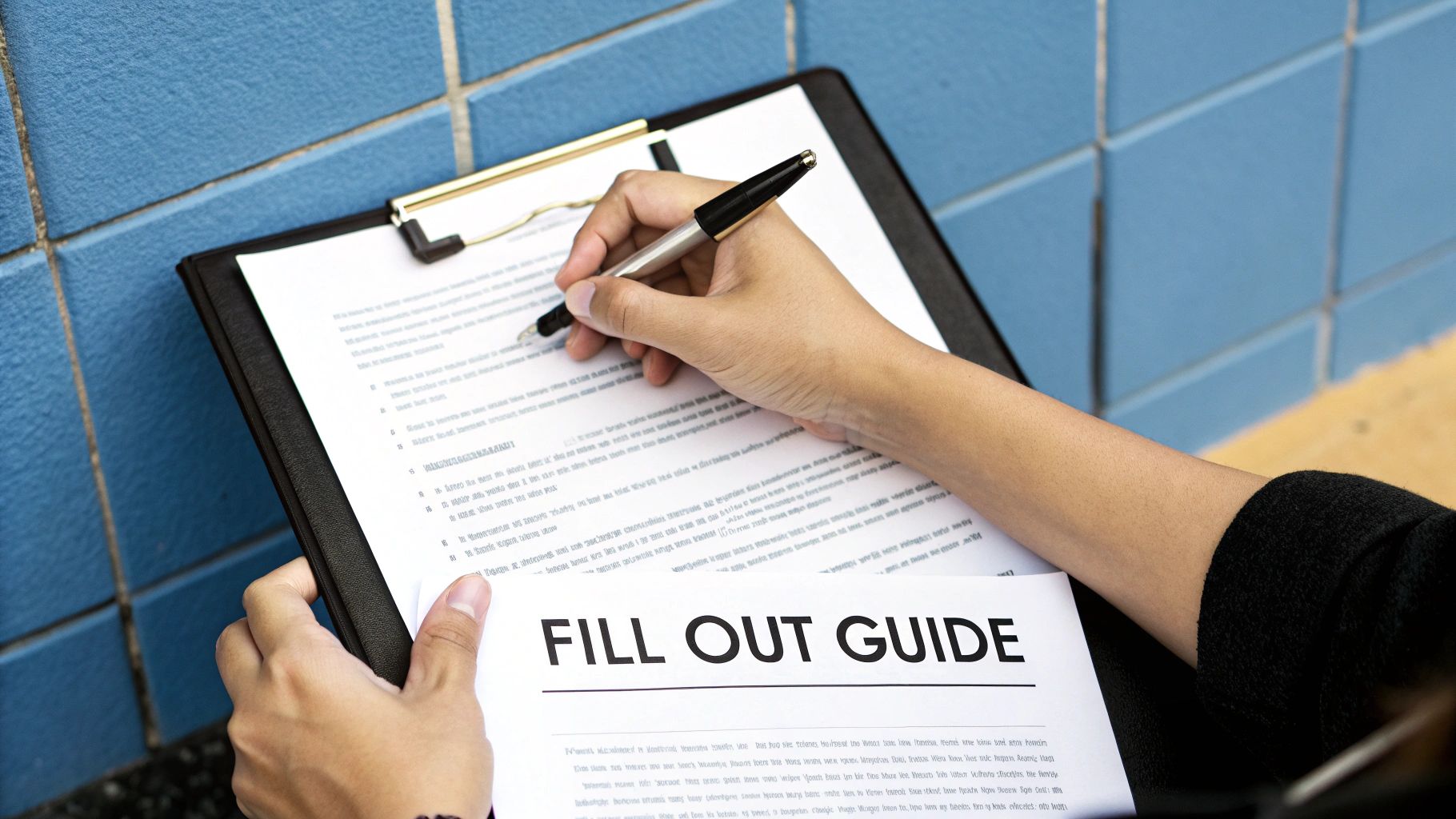
Templates Organized by Business Need
To make things even simpler, we've sorted our free templates by common professional scenarios. Each one is built with a specific job in mind, so you can grab the one that aligns perfectly with what you're trying to do.
-
Simple General Use Template: This is your everyday workhorse. It’s got a clean, minimalist design with just the essentials—sender, recipient, date, page count, and a spot for comments. It’s perfect for routine messages where you just need to be clear and direct.
-
Corporate Branded Template: If you want to keep your branding consistent, this one's for you. It includes a dedicated spot for your company logo and has a slightly more formal layout. This little touch reinforces your professionalism and makes your faxes instantly recognizable.
-
Legal and Confidential Template: When security is your top concern, reach for this template. It features a bold, can't-miss confidentiality notice right at the bottom. This statement makes it clear the information is privileged and intended only for the recipient—an absolute must for legal, healthcare, and financial documents.
Choosing the right template isn't just about looks; it's about function. A legal firm needs the clear disclaimer of a confidential template, while a small business benefits from the brand reinforcement of a corporate design.
How to Download and Edit Your Template
Getting your cover sheet ready is a breeze. We've broken it down into a simple, three-step process anyone can follow.
- Choose Your Template: Pick the template (Simple, Corporate, or Confidential) that best fits your needs from the options above.
- Select Your Format: Click the link for your preferred file type—Word, Google Docs, or PDF. It will either download straight to your computer or pop open in a new tab.
- Fill and Send: Open the file, type in the required information, and save your completed cover sheet. It's now ready to send with your document.
This straightforward process means you can create a polished, effective fax cover sheet without any hassle. If you're dealing with particularly sensitive information, you can learn more about creating a specialized https://payperfax.com/is-fax-still-used/confidential-cover-sheet/ to meet strict privacy standards.
Many organizations find it useful to have a library of templates for various needs, like a detailed grant budget template for securing funding. Using these ready-made resources saves you valuable time and ensures your documents always look professional.
Making Your Fax Template Your Own: Branding and Security
A blank fax cover sheet template is a great starting point, but the real magic happens when you customize it. Think of a generic template like a blank canvas. By adding your own touches, you can turn a simple, functional page into a powerful tool for your brand, your professional image, and, most importantly, your security.
This isn't just about looking good. It’s about building trust and making sure your communications are instantly recognizable and handled with the right level of care. Whether you're using a modern online fax service or a classic machine, these small changes create a consistent, secure experience for anyone on the receiving end.
Adding Your Brand's Stamp
Your fax cover sheet is often the first thing a recipient sees, making it a tiny but mighty piece of your company's identity. Making it instantly recognizable is a simple way to boost your professional image.
- Pop Your Company Logo on Top: The quickest way to show who a fax is from is to place your logo right at the top of the page. It adds instant credibility and helps your document stand out.
- Use Brand Colors and Fonts: If your company has a specific color scheme or font style, work it into your template. Consistency across all your communications—from your website to your faxes—builds a much stronger brand.
- Keep Your Message Clear and Brief: The "Comments" or "Message" section is for short, to-the-point information, not a novel. Keep it professional and actionable.
These little branding tweaks do a lot of heavy lifting. They ensure your faxes don't get lost in a pile and show you take every aspect of your business communication seriously.
Why the Confidentiality Notice is a Non-Negotiable
While branding makes you look professional, the confidentiality notice is probably the single most important customization for security and legal compliance. This small paragraph is your legal safety net, especially when you're sending sensitive information.
It might seem old-school, but faxing has stuck around precisely because it's seen as secure for official documents. A 2017 IDC survey projected a surprising 25% year-over-year growth in fax usage. That same year, people in the United States sent an estimated 200 billion fax pages—that works out to about 6,000 pages every single second. With that kind of volume, a cover sheet with a solid confidentiality notice is absolutely essential for making sure documents land in the right hands. You can see more surprising fax industry statistics if you're curious.
A confidentiality notice has one clear job: to formally state that the document is private, meant only for the person it's addressed to, and that anyone else is strictly prohibited from reading, sharing, or copying it. This isn't just polite boilerplate text; it’s a necessary legal disclaimer that protects your organization.
For industries like healthcare (think HIPAA), finance, or law, a confidentiality notice isn't just a good idea—it's mandatory for compliance. It proves you've taken reasonable steps to protect private information, which can be a lifesaver if a fax accidentally goes to the wrong number.
Here’s a standard confidentiality notice you can adapt for your own fax cover sheet template:
"CONFIDENTIALITY NOTICE: The information contained in this facsimile transmission is legally privileged and confidential, intended only for the use of the individual or entity named above. If the reader of this message is not the intended recipient, you are hereby notified that any dissemination, distribution, or copying of this communication is strictly prohibited. If you have received this communication in error, please immediately notify the sender by telephone and return the original message to us at the address above via the U.S. Postal Service. Thank you."
By customizing your template with these elements, you're elevating it from a simple piece of paper to an active part of your branding and security strategy. It ensures every fax you send is not only professional and recognizable but also protected by clear, legally sound safeguards.
Your Fax Cover Sheet Questions, Answered
Even with a solid template in hand, you're bound to run into some practical questions when you're about to send a fax. That's perfectly normal. This section is here to give you clear, straightforward answers to the most common things people ask, so you can handle any faxing situation with confidence. Think of it as your quick reference guide for avoiding rookie mistakes.
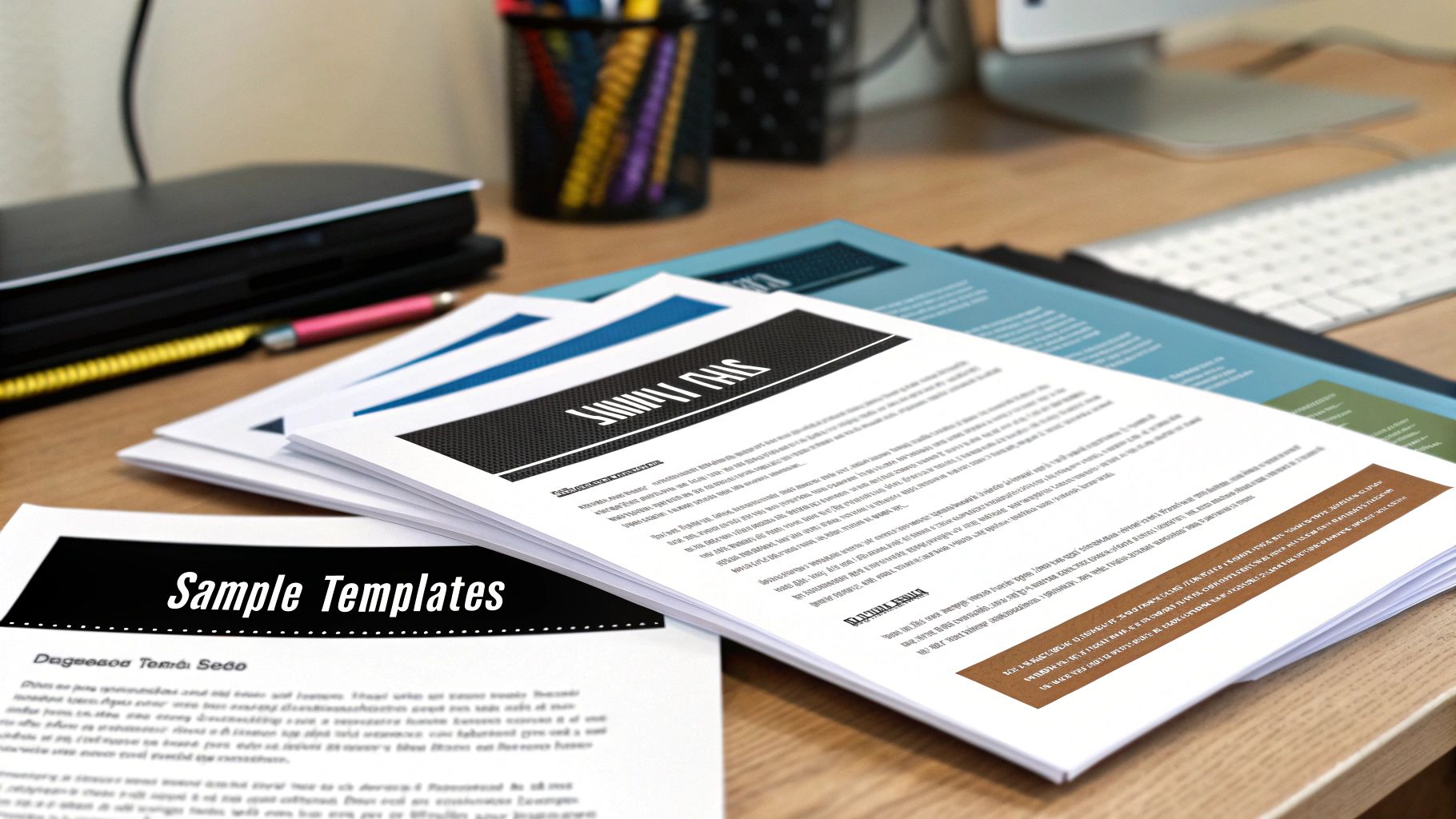
Is a Fax Cover Sheet Legally Required?
This is a great question, and the answer is: it depends. While there isn't a universal law that says every single fax must have a cover sheet, it's absolutely a best practice for security and looking professional.
Where it becomes non-negotiable is in regulated fields like healthcare or law. For anyone dealing with HIPAA compliance, for instance, a cover sheet moves from being a "nice-to-have" to an essential tool for protecting sensitive information. The confidentiality notice alone is a critical first line of defense.
Does the Cover Sheet Count as the First Page?
Yes, it always counts as page one. Always. When you fill out the total page count on the cover sheet itself, you must include it in the final number (e.g., "Page 1 of 5").
This isn't just a formality; it's a crucial safeguard. It gives the person on the other end an immediate way to check if they received the entire document. If your cover sheet says "5 pages" but they only see 4 come out of their machine, they know right away that something got lost in transmission—a surprisingly common issue with older fax lines.
Always count the cover sheet as page one. This single action is your best defense against incomplete transmissions and the confusion that follows, ensuring your recipient has everything you intended to send.
Can I Send a Fax Without a Cover Sheet?
Technically, yes, you can. But you really shouldn't. It's highly unprofessional and opens the door to all sorts of unnecessary risks. Sending a business document without a cover sheet is like sending a formal letter in the mail without an envelope—it just feels incomplete and careless.
Without it, your document arrives with no context. Who sent it? Who is it for? How many pages should there be? This dramatically increases the odds of it getting lost on someone's desk, being seen by the wrong eyes, or even causing a security issue if the information is confidential.
What Is the Most Important Information to Include?
If you're in a hurry and can only include the bare essentials, there are a few non-negotiable details that every effective fax needs. Think of these as the "must-haves" for your template.
- Recipient’s Name & Fax Number: Gets it to the right person.
- Sender’s Name & Contact Info: So they know who it's from and can reply.
- Date of Transmission: Creates a clear timestamp for everyone's records.
- Total Page Count: The only way for them to confirm they got everything.
- A Clear Subject Line: Tells them what it's about at a single glance.
Sending a fax should be simple, secure, and affordable, without locking you into a subscription. For a hassle-free solution, try PayPerFax. Send documents globally right from your browser and only pay for what you send. Visit https://payperfax.com to send your first fax in minutes.

